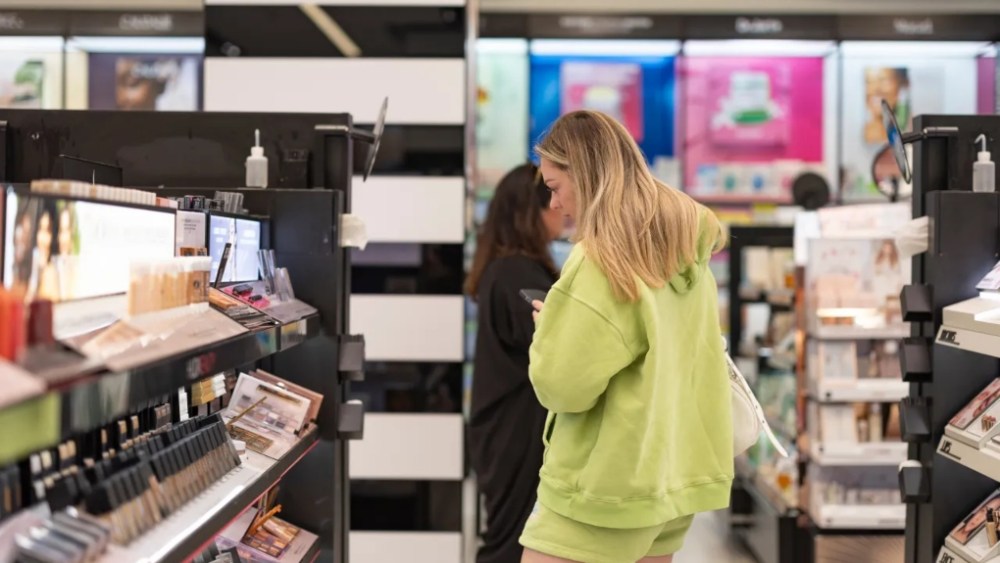Teen beauty spend is up — and not by a little.
Findings from Piper Sandler’s biannual Taking Stock With Teens survey indicate female teen beauty spend reached double-digit growth of 10 percent year-over-year, with all categories seeing increases except for hair, which remained relatively flat. The report surveyed 6,455 teens across 43 states in the U.S.
Fragrance was the fastest-growing category among the cohort (reflective of its standing overall, too), with fragrance spend up 22 percent year-over-year among girls and up 44 percent among teen boys. This comes as men’s fragrances continue to outpace women’s in sales growth, according to Circana, and younger male entrants take increased interest in designer scents, dupes and viral oud-y brands like Lattafa and Rayhaan, which are standouts of TikTok Shop’s burgeoning fragrance business.

Jean Paul Gaultier ranked as the number-one fragrance brand among teen boys surveyed.
Courtesy Photo
Fifty-three percent of teen boys and 78 percent of teen girls surveyed reported wearing fragrance every day, up from 43 percent and 66 percent in 2023. Boys are spending more on fragrances, though, with their fragrance spend reaching an average $127 annually (up from $88 last spring) and teen girl spend at $107 (versus $87 last spring).
Teen girls’ favorite fragrance brands, spring 2025, per Piper Sandler:
- Bath & Body Works: 20 percent
- Sol de Janeiro: 18 percent
- Victoria’s Secret: 10 percent
- Dior: 4 percent
- Billie Eilish: 4 percent
- Valentino Beauty: 4 percent
- Carolina Herrera: 3 percent
- Ariana Grande: 3 percent
- YSL Beauty: 3 percent
- Burberry: 3 percent
Teen boys’ favorite fragrance brands, spring 2025:
- Jean Paul Gaultier: 11 percent
- Versace: 10 percent
- Dior: 9 percent
- YSL Beauty: 8 percent
- Valentino Beauty: 6 percent
- Giorgio Armani: 4 percent
- Ralph Lauren: 4 percent
- Paco Rabanne: 3 percent
- Azzaro: 3 percent
- Dolce & Gabanna: 3 percent
This teen perfume boom has also propelled Bath & Body Works to the number-three retailer position among teen girls — it previously didn’t crack the top five — with 7 percent share, beating out Target, Amazon and Walmart, and tracking behind Ulta Beauty, which has a 26 percent, and Sephora, 38 percent.
Since overtaking Ulta as female teens’ number-one beauty destination in the survey’s fall 2023 iteration, Sephora has maintained its position, even gaining two share points this spring. Ulta and Target on the other hand continued to cede share as the beauty retailer race for young consumers’ loyalty intensifies.
For the first time, Piper Sandler surveyed teen boys on their favorite beauty shopping destinations, too, and their preferences look different.
Teen boys’ favorite beauty shopping destinations, spring 2025:
- Amazon: 29 percent
- Sephora: 10 percent
- Macy’s: 8 percent
- Target: 8 percent
- Ulta: 7 percent
- Walmart: 7 percent
- Bath & Body Works: 3 percent
- Fragrancenet.com: 2 percent
- Dillard’s: 2 percent
- Jomashop: 2 percent
On a brand level, Amika was the number-one hair care brand at 9 percent share; E.l.f. Cosmetics was on top in makeup at 35 percent, and CeraVe was number one in skin care at 32 percent. CeraVe was also the top skin care brand among teen boys, specifically.

CeraVe is the number-one skin care brand among teens overall, and among teen boys in particular.
Photo Courtesy of CeraVe
The top four cosmetics brands among teens surveyed have remained the same for the past two years — those being E.l.f. Cosmetics, Selena Gomez’s Rare Beauty, Maybelline New York and Charlotte Tilbury, in that order — though meaningful motion can be seen further on in the ranking.
This spring, Hourglass Cosmetics, Tower 28 and One/Size by Patrick Starr all entered the top 20 for the first time, while MAC Cosmetics fell out of the top 20 after steadily dropping in rank over the last few years.
In skin care, Shiseido-owned Drunk Elephant — formerly the seeming brand of choice for so-called “Sephora kids” — fell out of the top 10 among teen girls for the first time in years, coming in at 11th, while Hailey Bieber’s Rhode entered the top 20 for the first time at number 14. Interestingly, viral K-beauty indie Anua rose to number 13 after first cracking the top 20 last fall. Known for its heartleaf-infused oil cleansers and toners, the brand is a sensation on TikTok, and was snapped up by Ulta in January for its first U.S. retail foray.

Hailey Bieber’s Rhode is a key skin care share gainer among teens.
Courtesy of Rhode/Harley Weir
Teen girls’ favorite skin care brands in spring 2025:
- CeraVe: 32 percent
- The Ordinary: 11 percent
- La Roche-Posay: 8 percent
- Cetaphil: 4 percent
- Glow Recipe: 4 percent
- E.l.f. Skin: 3 percent
- Bubble: 3 percent
- Neutrogena: 3 percent
- PanOxyl: 2 percent
- Good Molecules: 2 percent
Teen boys’ favorite skin care brands in spring 2025:
- CeraVe: 52 percent
- Cetaphil: 5 percent
- Dove: 4 percent
- Neutrogena: 3 percent
- La Roche-Posay: 3 percent
- Native: 2 percent
- The Ordinary: 2 percent
- Old Spice: 1 percent
- Proactiv: 1 percent
- Dr. Squatch: 1 percent
In hair, Native — which entered hair care in 2021 — was the number-one brand among teen boys at 12 percent of share, while Dove came in second at 10 percent. Mass-market curly and natural hair care brands like SheaMoisture, Camille Rose and Cantu Beauty ranked fifth, sixth and seventh, respectively. Among teen girls, Not Your Mother’s took the number-two spot following Amika, holding onto the rank since last fall, while Garnier, Tresemmé and Dae Hair all gained share within the top 20.
Across the 6,455 teens surveyed, 54 percent were female; 45 percent were male, and 1 percent were nonbinary. The average age was 16.2 years old, and 37 percent of participants were employed part-time.

